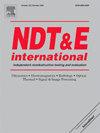Material parameter inversion using cross-entropy optimization based on Lamb Wave dispersion spectra
IF 4.1
2区 材料科学
Q1 MATERIALS SCIENCE, CHARACTERIZATION & TESTING
引用次数: 0
Abstract
For plate-like structures, non-destructive testing using ultrasonic Lamb waves has found many applications as oscillation modes and dispersion properties depend directly on the elastic material parameters. However, the dispersive nature of these modes complicates the analysis in the temporal–spatial domain. Instead, the frequency–wavenumber domain has proven advantageous because it allows the separation of simultaneously excited modes. Inversion of dispersion information to determine material properties is still a matter of research.
This paper proposes an algorithm based on the cross-entropy method which has been proven successful for many challenging optimization problems. This algorithm is used to determine the elastic properties (specific Lamé parameters) and the layer thickness of isotropic samples directly from the dispersion data of Lamb waves. This allows a full characterization of the elastic properties of the material in the case of known density. A cost function is developed that works directly on the raw dispersion data, requiring no thresholding or mode detection. The convergence of this method is shown to be wide with parameter search ranges of 300% or more.
The properties of the cost function were investigated by parameter study. The algorithm is evaluated through finite element simulations of Lamb wave propagation in three different isotropic materials. The findings indicate an average error of less than 1%. Measurement data for four samples (two steel plates; fused silica and lithium niobate wafers) show a strong correlation with literature values for the elastic parameters. The estimated thicknesses align with the measured values within the and are in agreement with literature values.

求助全文
约1分钟内获得全文
求助全文
来源期刊

Ndt & E International
工程技术-材料科学:表征与测试
CiteScore
7.20
自引率
9.50%
发文量
121
审稿时长
55 days
期刊介绍:
NDT&E international publishes peer-reviewed results of original research and development in all categories of the fields of nondestructive testing and evaluation including ultrasonics, electromagnetics, radiography, optical and thermal methods. In addition to traditional NDE topics, the emerging technology area of inspection of civil structures and materials is also emphasized. The journal publishes original papers on research and development of new inspection techniques and methods, as well as on novel and innovative applications of established methods. Papers on NDE sensors and their applications both for inspection and process control, as well as papers describing novel NDE systems for structural health monitoring and their performance in industrial settings are also considered. Other regular features include international news, new equipment and a calendar of forthcoming worldwide meetings. This journal is listed in Current Contents.
 求助内容:
求助内容: 应助结果提醒方式:
应助结果提醒方式:


